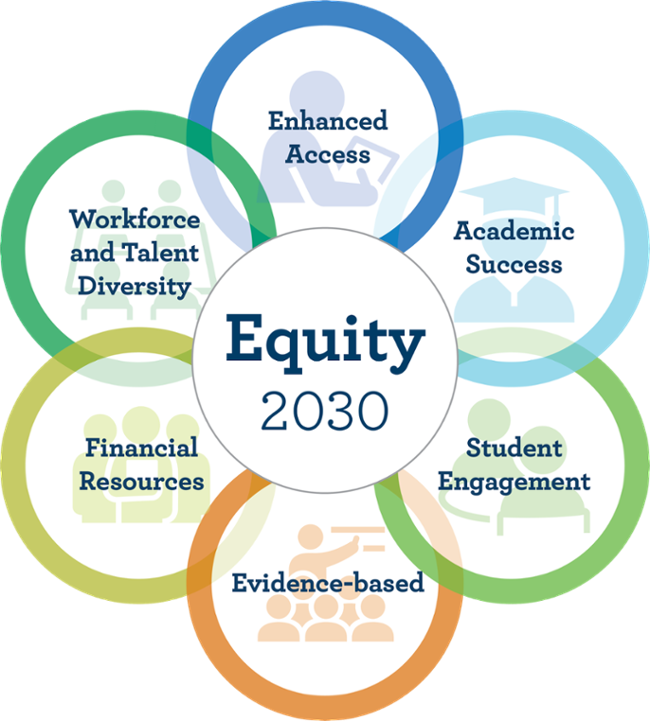Equity 2030 Goals

By 2030, Minnesota State will eliminate the educational equity gaps for first-generation students, low-income students, indigenous students and students of color at every Minnesota State college and university. To achieve this, we must enhance access and increase student success by:
- Increasing student retention, persistence, and graduation;
- Increasing the percent of Minnesotans age 25 to 44 who have attained a postsecondary certificate or degree to 70 percent across all populations;
- Increasing market share of high school graduates and the transfer rate from our two-year colleges to our universities: and
- Increasing the number of post-traditional (adult) learners
Equity 2030 Strategic Dimensions
While there is only one goal for Equity 2030, achieving that goal will require coordination and work across multiple areas of Minnesota State. In order to help organize the work and help each member of the Minnesota State community see how their role can contribute to Equity 2030, six strategic dimensions have been identified:
Enhanced Access
Enhanced Access entails strengthening partnerships and collaboration with elementary and secondary education,business and industry, community-based organizations, and philanthropic partners to expand and grow current programming and identify new ways to support students
More LessMinnesota State will seek to:
- Create partnerships with diverse communities and communities of color, including inviting them to create cultural competency leadership and professional development to help Minnesota State employees learn about what is important and valued within their communities.
- Develop industry champions who will advocate for maintenance and increase in state support for Minnesota State.
Minnesota State has several existing initiatives that relate to this goal:
- Post-secondary Education Options, concurrent enrollment, and Early College, which create early pipelines to higher education for secondary students
- Work-based learning
- Expansion of credit for prior learning under the Lumina All Learning Counts grant
- Comprehensive Workforce Solutions
Student Academic Success
By establishing guided learning pathways that focus on academic preparation, progression, and accomplishment within an area of study and career, Minnesota State will increase and improve student academic success
More LessGuiding principles for this work include:
- Equitable Outcomes: Close retention and graduation gaps for BI/IPOC, first-generation, and low-income students.
- Create and sustain pathways to meaningful credentials for new and returning students of all ages across the state.
- Inclusive Excellence: Maintain and continue to improve high quality programs for all students, faculty, staff, and administrators.
Existing initiatives within Minnesota State that relate to this goal include:
- Common guided learning pathways framework
- Developmental education curricula redesign
- Career Technical Education career pathways from K-12 to postsecondary
- Discipline-specific transfer pathways from associates to bachelor’s degrees
- Tackling transfer strategy
- Credit for prior learning expansion
- Campus Climate/Student Academic Experience review
- Cultural competency education for students
- Culturally responsive curriculum/pedagogy
- Delivery modes
Student Engagement and Support
Improving opportunities within the institutionand across the state for student engagement and support, both academic and non-academic, including supporting student access to resources to meet basic needs, will enable more students to attend college and earn a credential
More LessMinnesota State currently provides opportunities for engagement and support through:
- Comprehensive orientation and first year experience
- Holistic advising and comprehensive student support
- Linkages between service providers and external agencies/partners for support
- Campus Climate
- CRM
- Student One-Stop shops
Data-Guided Decision-Making
Making sure that the right people have access to the right information at the right times as well as authority and information necessary to intervene effectively when needed will be essential for Equity 2030 to succeed
More LessMinnesota State initiatives that relate to this dimension include:
- NextGen ERP Implementation
- Predictive analytics pilot project
- Assessment of system and campus Institutional Research capacity and expertise
- Equity by Design
- Professional development for faculty and staff
Financial Resources and Support
Engagement with community partners to combine efforts and resources may open opportunities for student support that are previously unused
More LessExisting initiatives within the System that relate to this goal:
- Workforce Development Scholarship Program
- Emergency grant funds
- Legislative advocacy
- Shared Services expansions
Workforce Diversity and Strategic Talent Management
Minnesota State will also encourage workforce and industry partners to adopt and implement worker-centered policies that support lifelong learning
More LessThese policies may include:
- Stable week-to-week working schedules that allow options for flexibility to attend courses and participate in collaborative projects;
- Allowances for childcare during both work and school hours;
- Assisting with transportation needs;
- Creating space in workplace environments for workers to study or attend remote courses; and
- Providing tuition assistance and health insurance coveragefor part-time workers who are enrolled in college courses.
Minnesota State currently provides the following resources to support workforce diversity and strategic talent management:
- Campus Climate Assessment/Employee Engagement
- Prioritize strategic diversity, equity, and inclusion processes for hiring and retention
- Development of culturally competent focused education and training for employees
- Professional development for students, faculty, staff, and Board of Trustees

